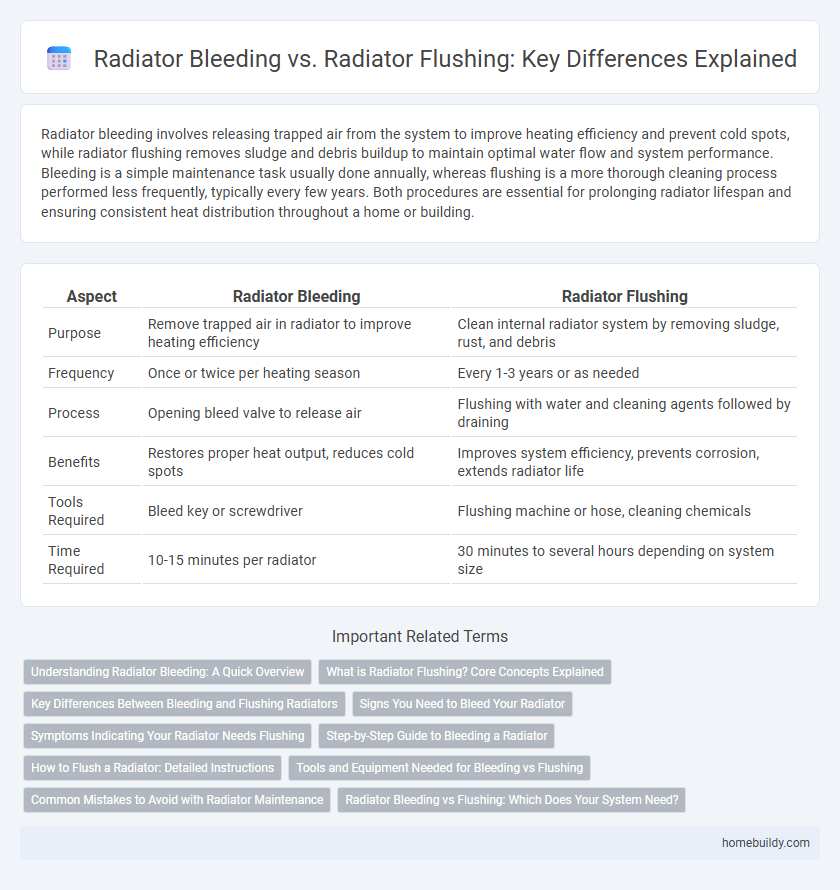Radiator bleeding involves releasing trapped air from the system to improve heating efficiency and prevent cold spots, while radiator flushing removes sludge and debris buildup to maintain optimal water flow and system performance. Bleeding is a simple maintenance task usually done annually, whereas flushing is a more thorough cleaning process performed less frequently, typically every few years. Both procedures are essential for prolonging radiator lifespan and ensuring consistent heat distribution throughout a home or building.
Table of Comparison
| Aspect | Radiator Bleeding | Radiator Flushing |
|---|---|---|
| Purpose | Remove trapped air in radiator to improve heating efficiency | Clean internal radiator system by removing sludge, rust, and debris |
| Frequency | Once or twice per heating season | Every 1-3 years or as needed |
| Process | Opening bleed valve to release air | Flushing with water and cleaning agents followed by draining |
| Benefits | Restores proper heat output, reduces cold spots | Improves system efficiency, prevents corrosion, extends radiator life |
| Tools Required | Bleed key or screwdriver | Flushing machine or hose, cleaning chemicals |
| Time Required | 10-15 minutes per radiator | 30 minutes to several hours depending on system size |
Understanding Radiator Bleeding: A Quick Overview
Radiator bleeding involves releasing trapped air from the heating system to restore efficient heat distribution and prevent cold spots, typically done by opening bleed valves until water flows smoothly. Radiator flushing, in contrast, cleans out sludge, rust, and debris buildup inside the radiator to improve water flow and system efficiency. Regular bleeding maintains optimal heating performance, while flushing extends the radiator's lifespan and prevents corrosion.
What is Radiator Flushing? Core Concepts Explained
Radiator flushing involves the process of removing old, contaminated coolant and debris from a vehicle's cooling system to improve heat transfer efficiency and prevent corrosion. This procedure typically uses a specialized flushing solution to dissolve sludge, rust, and scale buildup inside the radiator and engine cooling passages. Regular radiator flushing enhances engine performance, prevents overheating, and extends the lifespan of the cooling system components.
Key Differences Between Bleeding and Flushing Radiators
Radiator bleeding involves releasing trapped air from the system to restore proper heating efficiency, while radiator flushing cleans out accumulated sludge and debris to improve overall system performance. Bleeding is a quick maintenance step addressing immediate heating issues, whereas flushing is a more intensive process targeting long-term system health. Understanding these key differences ensures timely and effective radiator care for optimal home heating.
Signs You Need to Bleed Your Radiator
Radiator bleeding is necessary when you notice uneven heating, cold spots on the radiator, or a gurgling noise caused by trapped air disrupting the coolant flow. Flushing a radiator addresses sludge buildup and corrosion but does not resolve trapped air issues. Recognizing symptoms like inconsistent warmth and strange noises helps distinguish when bleeding is required to restore efficient heating performance.
Symptoms Indicating Your Radiator Needs Flushing
Persistent cold spots on radiators, rusty or discolored water, and reduced heating efficiency are key symptoms indicating your radiator needs flushing. Radiator flushing removes sludge, rust, and debris buildup that cause blockages and uneven heat distribution, unlike bleeding which only releases trapped air. Regular flushing enhances system performance and prevents corrosion, maintaining optimal heat output throughout the heating system.
Step-by-Step Guide to Bleeding a Radiator
Radiator bleeding involves releasing trapped air to improve heating efficiency by opening the bleed valve with a radiator key until water flows steadily. Radiator flushing, by contrast, clears sludge and debris through a power flush using water and cleaning agents inside the system. Regular bleeding prevents cold spots and ensures optimal heat distribution, while flushing maintains radiator longevity and system performance.
How to Flush a Radiator: Detailed Instructions
To flush a radiator effectively, start by turning off the heating system and allowing the radiator to cool completely. Next, close the valves and place a container beneath the drain valve to catch old water; then, open the valve to drain the radiator fully. Refill the radiator with a radiator flushing solution mixed with water, run the heating system for about 30 minutes to circulate the cleaner, then drain and rinse the radiator thoroughly with clean water before closing the valves and refilling with fresh water or antifreeze.
Tools and Equipment Needed for Bleeding vs Flushing
Radiator bleeding typically requires a simple radiator key or screwdriver to release trapped air and restore optimal heating efficiency. In contrast, radiator flushing demands more specialized equipment such as a power flush machine, hoses, and suitable chemical cleaners to remove sludge and debris thoroughly. Proper use of these tools ensures effective maintenance, with bleeding addressing air pockets and flushing targeting internal blockages.
Common Mistakes to Avoid with Radiator Maintenance
Avoid common mistakes like neglecting to bleed trapped air from radiators, which can cause uneven heating and reduce system efficiency. Skipping radiator flushing allows sludge and debris buildup, leading to blockages and corrosion that impair heat transfer. Regular bleeding combined with periodic flushing ensures optimal radiator performance and extends the lifespan of the heating system.
Radiator Bleeding vs Flushing: Which Does Your System Need?
Radiator bleeding removes trapped air pockets that prevent efficient heat distribution, essential for maintaining optimal system performance in most central heating systems. Radiator flushing, on the other hand, clears accumulated sludge and rust build-up inside the radiator, which is crucial when the heating output decreases or cold spots appear. Evaluating your system's symptoms helps determine whether bleeding or flushing is necessary to restore efficient heating and prolong radiator lifespan.
Radiator Bleeding vs Radiator Flushing Infographic

 homebuildy.com
homebuildy.com